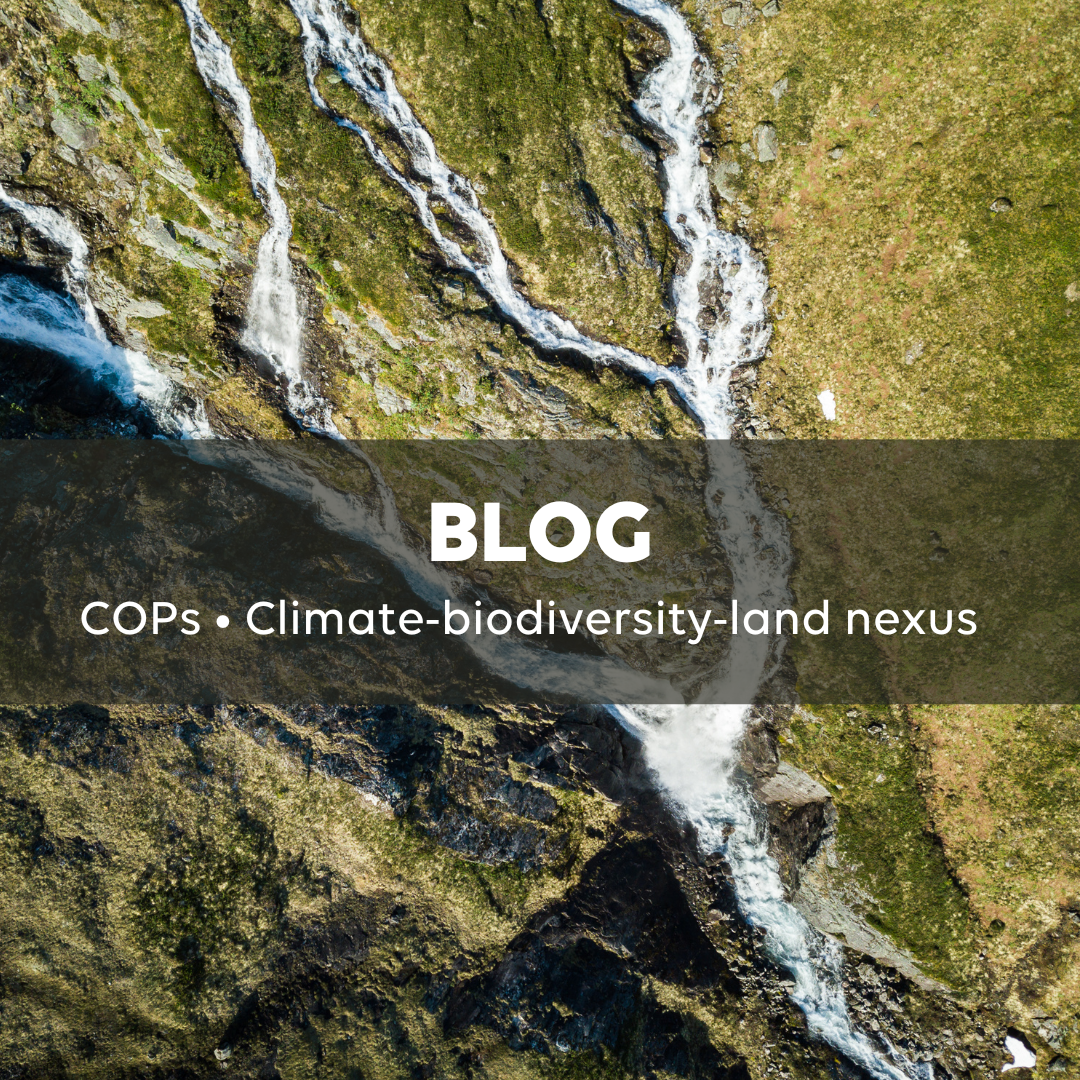Leveraging the Climate-Biodiversity-Land nexus in a triple-COP year
[October 2024] With the COPs of the three Rio conventions, the end of 2024 will mark the midway point to several long- and medium-term term objectives set for 2030. It is thus a crucial moment to take stock of progress and maximise synergies across the climate, biodiversity and desertification agendas.

Analysis note of the Global Observatory of Climate Action
Author: Tania Martha Thomas, Coordinator of the Observatory
Date: October 2024
Summary:
- CBD COP16: Operationalising the Kunming-Montreal Global Biodiversity Framework
- UNFCCC COP29: The “Finance COP”
- UNCCD COP16: Largest yet mobilisation against desertification
- Ecosystems at the centre of the Climate-Biodiversity-Land nexus
Approaching the halfway point for the “Decade of Action” to achieve the Sustainable Development Goals (SDGs) by 2030, the upcoming months, marked by a frequent and rapid succession of high-level international meetings, will be crucial to charting and scaling up the global response to the ongoing planetary crises. 2024 will see three back-to-back COPs (Conference of Parties) of the three Rio Conventions that date back to the 1992 Earth Summit: the UN Framework Convention on Climate Change (UNFCCC), the Convention on Biological Diversity (CBD) and the UN Convention to Combat Desertification (UNCCD). Under the mandates of each of these conventions, the mid-point of the decade is a crucial moment for action. It will also be the moment for all stakeholders to align their objectives, plans and actions across the three agendas.
These meetings arrive at a critical stage, where geopolitical conflict and trade tensions add to countries’ concerns alongside more intense climatic events. This year is also set apart for it will have been the “year of elections”, with elections taking place in countries home to nearly half the global population.[1] The three COPs will take place following the adoption of the Pact for the Future by the UN General Assembly, with countries pledging to 56 actions that aim at progress in sustainable development – to correct the current course on the SDGs – but also addressing interrelated issues of climate action, peace and security, digital cooperation, human rights, gender, youth and future generations.[2] The Pact re-affirmed countries’ commitment to transition away from fossil fuels, though the level of ambition remains unchanged.[3]
CBD COP16: Operationalising the Kunming-Montreal Global Biodiversity Framework
The CBD’s sixteenth Conference of Parties will take place from 21 October to 1 November, in Cali, Colombia. The priority will be to translate the commitments of the Kunming-Montreal Global Biodiversity Framework (GBF) adopted at COP15 in 2022, into concrete actions. This includes supporting countries in ensuring that their National Biodiversity Strategies and Actions Plans (NBSAPs) are in line with the GBF’s 23 targets, including the 30×30 target: conserving 30% of earth’s land and seas by 2030, through the establishment of protected areas or through other area-based conservation measures.[4]
Among other priorities, notably highlighted by civil society or research organizations are:[5],[6],[7],[8],[9]
- Addressing the level of ambition of commitments, and making sure that they are followed through with implementation and, where appropriate, legislation
- Ensuring robust systems of monitoring and accountability for the GBF targets
- Mainstreaming biodiversity issues across all sectors, especially food, energy, human rights and development
- Financing the achievement of the GBF targets (the finance gap being estimated at $700 bn per year)[10], which like in the climate case, comes up as the key factor that will determine the success of implementation. More precisely, pressing issues include aligning finance flows with targets, widening access to finance for nature especially in developing countries, and for Indigenous Peoples and local communities – be it through alternate models like the bioeconomy, or through novel instruments like biodiversity credits.
As for the Colombian Presidency of the COP, the selected theme for this edition is “Peace with Nature”, with the country’s environment minister Susana Muhamad stating that the outcomes of this COP could contribute to peace efforts by « empowering and mobilizing local communities in regions where the armed struggle is happening, especially confronting illicit economies. »[11] This is in the context of large deforestation following the country’s 2016 peace deal with the FARC rebel group, which led to former fighters turning to unregulated farming, alongside other rebel groups which reject the peace deal and continue fighting. According to Global Witness, Colombia had the highest cumulative number of killings of environmental activists since 2012.[12]
UNFCCC COP29: The “Finance COP”
The most widely followed of the three, this year’s climate COP will take place in Baku, Azerbaijan, and has been dubbed “the finance COP”, as countries will have to set a New Quantified Collective Goal (NCQG) for climate finance flows. These negotiations, covering both the quantity, form and sources of finance, will hold the key to smoothing increasingly intense tensions between developed and developing countries over who will pay for the reduction of emissions, as well as adaptation and loss and damage. Negotiations on several other issues have in the past been blocked by questions of financing, and the previous goal of $100 bn per year by 2020 was only met by 2022 according OECD figures.[13]
While the finance question is at the forefront, negotiations will continue on other topics, as countries prepare the next round of their Nationally Determined Contributions (NDCs), more precisely the NDCs 3.0, which are due to be submitted before COP30 in 2025, and will cover the period up to 2035. These documents will thus have an important role in bridging current policies with medium-term ones, will be fed by the results from the First Global Stocktake under the Paris Agreement, which concluded in 2023. More robust NDCs and their implementation will depend on monitoring and transparency, a stated priority of the Azeri presidency.[14] Countries are also expected to submit their first round of Biennial Transparency Reports by the end of the year.
Among other areas of priority for continuing negotiations:
- Mitigation and the energy transition, and following through on the COP28 targets of tripling renewable capacities and doubling the rate of energy efficiency improvements by 2030. The transition away from fossil fuels, a hard-won and much talked about victory at Dubai, was conspicuous by its absence in the Azeri Presidency’s priorities.[15]
- Article 6 negotiations, carried on from the last two COPs, which will determine how carbon markets and international cooperation around the trade of credits can be operationalised
- Operationalising the UAE Framework for the Global Goal on Adaptation, which aims to bring adaptation at par with mitigation[16]
- Working out the details of the Loss and Damage funding, following the progress over the last year towards getting the Loss and Damage Fund up and running[17]
UNCCD COP16: Largest yet mobilisation against desertification
After the adoption of the 2018-2030 Strategic Framework, the establishment of land degradation baseline in 2018, followed by data-based assessments of land loss and restoration for the first time in 2023, the UNCCD continues to work towards its strategic objectives, including that of improving the condition of affected ecosystems, combating desertification/land degradation, promoting sustainable land management, and contributing to land degradation neutrality.[18] Other priorities of the relatively lesser-known UNCCD under this new framework are improving the living conditions of affected populations, enhancing drought resilience, generating global environmental benefits from the implementation of the convention, and mobilising financial and non-financial resources for implementation.
The previous COP of the UNCCD, in 2022 in Abidjan, Côte d’Ivoire, advanced negotiations between Parties on drought, gender, sand and dust storms, land-degradation induced migration, and for the first time, land tenure. The 2024 COP, charted to be the largest one yet of the CCD signatories, will be hosted by Saudi Arabia in Riyadh, and will “focus on mobilizing governments, businesses and communities worldwide to accelerate action on land restoration and drought resilience as a cornerstone of food, water and energy security”.[19] It will also be marked by the mid-term review of the implementation of the Strategic Framework, with the aim of making recommendations in view of 2030 targets. Also among the priorities for this COP is a shift from voluntary assessments and actions by countries to more harmonised ones globally, to achieve the COP15 goal of restoring 1.5 billion hectares of degraded land by 2030.[20]
Ecosystems at the centre of the Climate-Biodiversity-Land nexus
The One Health concept is an iteration of the “convergence” between the three Rio conventions and their objectives, and the Sustainable Development Goals, having gained particular importance with the outbreak of the Covid-19 pandemic.[21] In an op-ed for the World Economic Forum, Astrid Schomaker, Ibrahim Thiaw and Simon Stiell, the respective Executive Secretaries of the Biodiversity, Desertification and Climate Change Conventions, stressed on the interdependent goals of the three conventions.[22] Ecosystem restoration, agrifood systems and renewable energies are presented as areas of opportunity to advance all three agendas, while calling for greater coherence in policies and funding at national and subnational levels.
Indeed, ecosystems lie at the heart of solutions to the interlinked crises, their protection and restoration will contribute towards the objectives of the three conventions. The IPCC Working Group II report on Impacts, Adaptation and Vulnerability affirming that Nature-based Solutions (NbS) for adaptation to climate change will reduce risks and vulnerabilities of people and nature and contribute to resilience, while remaining feasible and effective.[23] For example, restoring wetlands will protect biodiversity will also reducing flood risks, or urban greening can re-introduce green belts in cities while reducing flood and heat-related risks. The application of NbS can thus contribute to the achievement of the global adaptation objective under the Paris Agreement, target 8 of the GBF relating to climate resilience, as well as the SDGs. Integrated implementation on the ground will contribute to the joint monitoring of indicators under the different conventions.[24]
Similarly, ecological connectivity can also respond to the priorities of the three Rio conventions – by protecting and conserving biodiverse zones and wildlife within them, rendering them more resilient to climate change, restoring degraded land, and even contributing to mitigation through sequestration in case of larger swathes of forest.[25]
While there are numerous synergies, there also exist trade-offs in the case of certain actions, which while beneficial on one front might do harm on another (for example, large-scale poorly planned solar or wind farms could affect biodiversity in the area). Avoiding such trade-offs also involves integrated planning for climate, biodiversity and land actions – right from the financing stage.[26]
References
[1] John, M. & Sen, S. (09/07/2024). How this year of elections is set to reshape global politics. Reuters.
[2] United Nations (2024). Pact for the Future, Global Digital Compact, and Declaration on Future Generations. Summit of the Future outcome documents.
[3] Frost, R. (23/09/2024). Major new UN pact reaffirms global commitment to transition away from fossil fuels. Euro News.
[‘] Convention on Biological Diversity (2022). DECISION ADOPTED BY THE CONFERENCE OF THE PARTIES TO THE CONVENTION ON BIOLOGICAL DIVERSITY. CBD/COP/DEC/15/4.
[5] Landry, J. & Hallosserie, A. (13/06/2024). Préparer le terrain pour la COP16 : un moment crucial pour le « Plan Biodiversité ». [billlet de Blog]. IDDRI.
[6] Ghannem, J. (19/04/2024). The countdown to biodiversity COP16 in Cali has begun. [blog]. GEF.
[7] WWF (11/09/2024). WWF outlines its expectations for COP16.
[8] The Nature Conservancy (18/09/2024). COP16: What’s at stake for the 2024 UN Biodiversity Conference.
[9] Sköld, M. et al. (22/05/2024). Three top priorities for biodiversity ahead of COP16. SEI.
[10] Convention on Biological Diversity (2022); op. cit.
[11] AFP. (23/09/2024). At COP16, Colombia seeks to lead by example on biodiversity. France24.
[12] Robson, M., Garate, J. & Thomson, A. (22/05/2024). Biodiversity and forest defenders – the stakes of COP16. Global Witness.
[13] OECD (29/05/2024). Climate Finance Provided and Mobilised by Developed Countries in 2013-2022. OECD.
[14] COP29 (n.d.). In Solidarity for a Green World. Accessed 01/10/2024.
[15] Bryan, K. (17/09/2024). COP29 host skips over fossil fuels to waste methane and energy storage. Financial Times.
[16] Thomas, T. M. (12/2023). Les progrès de l’Objectif mondial d’adaptation : Le chemin long et difficile vers un cadre flou. Climate Chance.
[17] Raya, T. Z. (15/08/2024). Progress of the Operationalisation of the Loss and Damage Fund: Key Takeaways from the Board Proceedings and What Lies Ahead. International Centre for Climate Change and Development.
[18] UNCCD (n.d.). UNCCD 2018-2030 Strategic Framework. Accessed 01/10/2024.
[19] UNCCD (21/01/2024). Saudi Arabia to host largest-ever UN conference on land and drought. [Press release]. UNCCD.
[20] Bompan, E. (02/08/2024). COP16 Desertification, interview with Alain-Richard Donwahi. Materia Rinnovabile.
[21] Cuvillard, O. & Gillod, A. (2022). Corridors de biodiversité : le renforcement de la connectivité écologique pour adapter les écosystèmes au changement climatique. Climate Chance.
[22] Schomaker, A., Thiaw, I. & Stiell, S. (23/09/2024). In this triple COP year, leaders must align efforts to ensure planetary health. World Economic Forum.
[23] Pörtner, H.-O. et al. (2022). Climate Change 2022: Impacts, Adaptation and Vulnerability. Contribution of Working Group II to the Sixth Assessment Report of the Intergovernmental Panel on Climate Change. Cambridge University Press.
[24] Griswold, D. et al (2022). Nature-based Solutions and the Global Goal on Adaptation. FEBA Issue brief for UNFCCC COP27. Friends of Ecosystem-based Adaptation.
[25] Cuvillard, O. & Gillod, A. (2022), op. cit.
[26] Finance for Biodiversity Foundation (10/2023). Unlocking the biodiversity-climate nexus. A practitioner’s guide for financial institutions.




